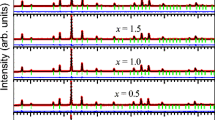Abstract
The study of the direct current electrical conductivity, σ, of freshly prepared γ-Fe2O3 and that of a sample stored for seven days in static air suggests that γ-Fe2O3 adsorbs oxygen and water from the atmosphere. From infra-red spectra it is deduced that the absorbed water in γ-Fe2O3 is present as the physically adsorbed water and as lattice water. The adsorbed oxygen and physically adsorbed water are removed by heating to 100‡ C, while the lattice water remains in γ-Fe2O3 even up to 280‡ C. The removal of lattice water is associated with a decomposition during which some of the hydrogen formed occupies the vacancy sites. This suggested formation of the hydrogen ferrite phase is based on the kink in the log σ against T −1 curve observed at 177‡ C. This kink is very well resolved for a sample equilibrated at 100‡ C in normal atmosphere, and the measurements of σ above 100‡ C of this sample are done in an N2 atmosphere. The suggestion that the hydrogen ferrite phase is formed has been substantiated by comparison of the X-ray diffraction patterns of γ-Fe2O3 heated under the different atmospheres. From the log σ against T −1 plot for a sample heated under a nitrogen atmosphere the activation energy is small (< 0.05 eV) up to 215‡ C, and it is comparatively large (0.95 eV) above 215‡ C. These results suggest a hopping mechanism for the direct current electrical conductivity of γ-Fe2O3. This suggestion has been substantiated by data of the temperature variation of Seebeck voltage.
Similar content being viewed by others
References
K. S. Rane, A. K. Nikumbh and A. J. Mukhedkar, J. Mater. Sci. 16 (1981) 2387.
R. Giovanoli and R. Brütsch, Chimia 28 (1974) 188.
J. M. D. Coey and D. Khalafalla, Phys. Stat. Sol. (a) 11 (1972) 229.
G. Y. Onoda Jr. and P. L. DeBruyn, Surface Sci. 4 (1966) 48.
R. Furuichi, N. Sato and G. Okamoto, Bull. Chem. Soc. Japan 42 (1969) 2475.
R. Furuichi, N. Sato and G. Okamoto, Chem. Abstracts 73 (1970) 60193.
W. Meyer, Z. Physik. 38 (1937) 1014.
F. A. Kroger, “The Chemistry of Imperfect Crystals” (North Holland Publishing Co., Amsterdam, 1964) p. 475.
A. Aharoni, E. H. Frei and M. Schieber, J. Phys. Chem. Solids 23 (1962) 545.
A. Kpjima, Sci. Rep. Res. Inst. Tohou Univ. A6 (1954) 178.
T. Masatami and H. Shuichi, Chem. Abstracts 85 (1976) 136297.
I. David and A. J. E. Welch, Trans. Faraday Soc. 52 (1956) 1642.
A. K. Nikumbh, Ph.D. Thesis, Poona University (1982).
I. G. Austin and N. F. Mott, Adv. Phys. 18 (1969) 41.
H. Takei and S. Chiba, J. Phys. Soc. Japan 21 (1966) 1255.
J. Yamashita and T. Kurosawa, ibid. 15 (1960) 802.
N. F. Mott, J. Non-Cryst. Solids 1 (1968) 1.
I. G. Austin, ibid. 2 (1970) 474.
E. J. W. Verwey, Z. Kristallogr. A91 (1935) 5.
K. P. Sinha and A. P. B. Sinha, Z. Anorg. Chem. 293 (1957) 228.
P. B. Braun, Nature, London 170 (1952) 1123.
E. W. Gorter, J. Phys. Radium 12 (1951) 189.
ASTM File number 25-1402.
G. Beech, “Fortran IV in Chemistry: An introduction to computer-assisted methods”, (John Wiley and Sons Ltd., New York, 1975) p. 142.
G. A. Fergusson and M. Hass, Phys. Rev. 112 (1958) 1130.
R. Ueda and K. Hasegawa, J. Phys. Soc. Japan. 17 (Suppl. BII) (1962) 391.
Author information
Authors and Affiliations
Rights and permissions
About this article
Cite this article
Nikumbh, A.K., Rane, K.S. & Mukhedkar, A.J. Direct current electrical conductivity of gamma ferric oxide. J Mater Sci 17, 2503–2513 (1982). https://doi.org/10.1007/BF00543881
Received:
Accepted:
Issue Date:
DOI: https://doi.org/10.1007/BF00543881




